Pesquisa sobre Binance Futures Multi-currency Hedging Strategy Parte 2
Autora:Bem-estar, Criado: 2020-05-09 16:03:01, Atualizado: 2024-12-12 21:00:59
O endereço do relatório de investigação original:https://www.fmz.com/digest-topic/5584Você pode lê-lo primeiro, este artigo não terá conteúdo duplicado. Este artigo irá destacar o processo de otimização da segunda estratégia. Após a otimização, a segunda estratégia é melhorada obviamente, recomenda-se atualizar a estratégia de acordo com este artigo. O mecanismo de backtest adicionou as estatísticas de taxa de manuseio.
# Libraries to import
import pandas as pd
import requests
import matplotlib.pyplot as plt
import seaborn as sns
import numpy as np
%matplotlib inline
symbols = ['ETH', 'BCH', 'XRP', 'EOS', 'LTC', 'TRX', 'ETC', 'LINK', 'XLM', 'ADA', 'XMR', 'DASH', 'ZEC', 'XTZ', 'BNB', 'ATOM', 'ONT', 'IOTA', 'BAT', 'VET', 'NEO', 'QTUM', 'IOST']
price_usdt = pd.read_csv('https://www.fmz.com/upload/asset/20227de6c1d10cb9dd1.csv ', index_col = 0)
price_usdt.index = pd.to_datetime(price_usdt.index)
price_usdt_norm = price_usdt/price_usdt.fillna(method='bfill').iloc[0,]
price_usdt_btc = price_usdt.divide(price_usdt['BTC'],axis=0)
price_usdt_btc_norm = price_usdt_btc/price_usdt_btc.fillna(method='bfill').iloc[0,]
class Exchange:
def __init__(self, trade_symbols, leverage=20, commission=0.00005, initial_balance=10000, log=False):
self.initial_balance = initial_balance # Initial asset
self.commission = commission
self.leverage = leverage
self.trade_symbols = trade_symbols
self.date = ''
self.log = log
self.df = pd.DataFrame(columns=['margin','total','leverage','realised_profit','unrealised_profit'])
self.account = {'USDT':{'realised_profit':0, 'margin':0, 'unrealised_profit':0, 'total':initial_balance, 'leverage':0, 'fee':0}}
for symbol in trade_symbols:
self.account[symbol] = {'amount':0, 'hold_price':0, 'value':0, 'price':0, 'realised_profit':0, 'margin':0, 'unrealised_profit':0,'fee':0}
def Trade(self, symbol, direction, price, amount, msg=''):
if self.date and self.log:
print('%-20s%-5s%-5s%-10.8s%-8.6s %s'%(str(self.date), symbol, 'buy' if direction == 1 else 'sell', price, amount, msg))
cover_amount = 0 if direction*self.account[symbol]['amount'] >=0 else min(abs(self.account[symbol]['amount']), amount)
open_amount = amount - cover_amount
self.account['USDT']['realised_profit'] -= price*amount*self.commission # Minus handling fee
self.account['USDT']['fee'] += price*amount*self.commission
self.account[symbol]['fee'] += price*amount*self.commission
if cover_amount > 0: # close position first
self.account['USDT']['realised_profit'] += -direction*(price - self.account[symbol]['hold_price'])*cover_amount # Profit
self.account['USDT']['margin'] -= cover_amount*self.account[symbol]['hold_price']/self.leverage # Free margin
self.account[symbol]['realised_profit'] += -direction*(price - self.account[symbol]['hold_price'])*cover_amount
self.account[symbol]['amount'] -= -direction*cover_amount
self.account[symbol]['margin'] -= cover_amount*self.account[symbol]['hold_price']/self.leverage
self.account[symbol]['hold_price'] = 0 if self.account[symbol]['amount'] == 0 else self.account[symbol]['hold_price']
if open_amount > 0:
total_cost = self.account[symbol]['hold_price']*direction*self.account[symbol]['amount'] + price*open_amount
total_amount = direction*self.account[symbol]['amount']+open_amount
self.account['USDT']['margin'] += open_amount*price/self.leverage
self.account[symbol]['hold_price'] = total_cost/total_amount
self.account[symbol]['amount'] += direction*open_amount
self.account[symbol]['margin'] += open_amount*price/self.leverage
self.account[symbol]['unrealised_profit'] = (price - self.account[symbol]['hold_price'])*self.account[symbol]['amount']
self.account[symbol]['price'] = price
self.account[symbol]['value'] = abs(self.account[symbol]['amount'])*price
return True
def Buy(self, symbol, price, amount, msg=''):
self.Trade(symbol, 1, price, amount, msg)
def Sell(self, symbol, price, amount, msg=''):
self.Trade(symbol, -1, price, amount, msg)
def Update(self, date, close_price): # Update assets
self.date = date
self.close = close_price
self.account['USDT']['unrealised_profit'] = 0
for symbol in self.trade_symbols:
if np.isnan(close_price[symbol]):
continue
self.account[symbol]['unrealised_profit'] = (close_price[symbol] - self.account[symbol]['hold_price'])*self.account[symbol]['amount']
self.account[symbol]['price'] = close_price[symbol]
self.account[symbol]['value'] = abs(self.account[symbol]['amount'])*close_price[symbol]
self.account['USDT']['unrealised_profit'] += self.account[symbol]['unrealised_profit']
if self.date.hour in [0,8,16]:
pass
self.account['USDT']['realised_profit'] += -self.account[symbol]['amount']*close_price[symbol]*0.01/100
self.account['USDT']['total'] = round(self.account['USDT']['realised_profit'] + self.initial_balance + self.account['USDT']['unrealised_profit'],6)
self.account['USDT']['leverage'] = round(self.account['USDT']['margin']/self.account['USDT']['total'],4)*self.leverage
self.df.loc[self.date] = [self.account['USDT']['margin'],self.account['USDT']['total'],self.account['USDT']['leverage'],self.account['USDT']['realised_profit'],self.account['USDT']['unrealised_profit']]
O desempenho da estratégia original, após a selecção do tipo de moeda, foi bom, mas ainda existem muitas posições de detenção, geralmente cerca de 4 vezes
Princípio:
- Atualizar as cotações de mercado e as posições da conta, o preço inicial será registado na primeira corrida (as moedas recém-adicionadas são calculadas de acordo com o momento da adesão)
- Atualize o índice, o índice é o índice de preço altcoin-bitcoin = média (suma ((preço altcoin / preço bitcoin) / (preço inicial altcoin / preço inicial bitcoin)))
- Julgar a operação longa e curta de acordo com o índice de desvio e julgar o tamanho da posição de acordo com o tamanho do desvio
- Colocando ordens, a quantidade de ordem é determinada pela estratégia de comissão iceberg e a transação é executada de acordo com o mais recente preço executável
- Volte a fazer o loop.
trade_symbols = list(set(symbols)-set(['LINK','XTZ','BCH', 'ETH'])) # Remaining currencies
price_usdt_btc_norm_mean = price_usdt_btc_norm[trade_symbols].mean(axis=1)
e = Exchange(trade_symbols,initial_balance=10000,commission=0.0005,log=False)
trade_value = 300
for row in price_usdt.iloc[:].iterrows():
e.Update(row[0], row[1])
empty_value = 0
for symbol in trade_symbols:
price = row[1][symbol]
if np.isnan(price):
continue
diff = price_usdt_btc_norm.loc[row[0],symbol] - price_usdt_btc_norm_mean[row[0]]
aim_value = -trade_value*round(diff/0.01,1)
now_value = e.account[symbol]['value']*np.sign(e.account[symbol]['amount'])
empty_value += now_value
if aim_value - now_value > 20:
e.Buy(symbol, price, round((aim_value - now_value)/price, 6),round(e.account[symbol]['realised_profit']+e.account[symbol]['unrealised_profit'],2))
if aim_value - now_value < -20:
e.Sell(symbol, price, -round((aim_value - now_value)/price, 6),round(e.account[symbol]['realised_profit']+e.account[symbol]['unrealised_profit'],2))
stragey_2b = e
(stragey_2b.df['total']/stragey_2b.initial_balance).plot(figsize=(17,6),grid = True);
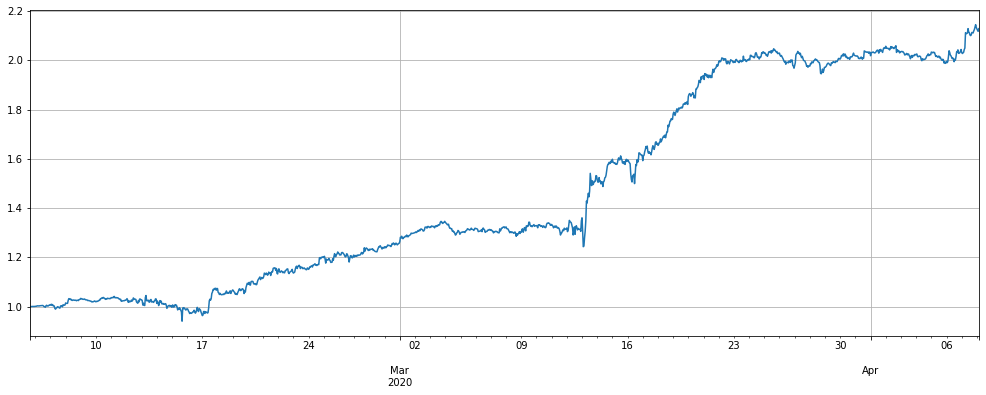
stragey_2b.df['leverage'].plot(figsize=(18,6),grid = True); # leverage
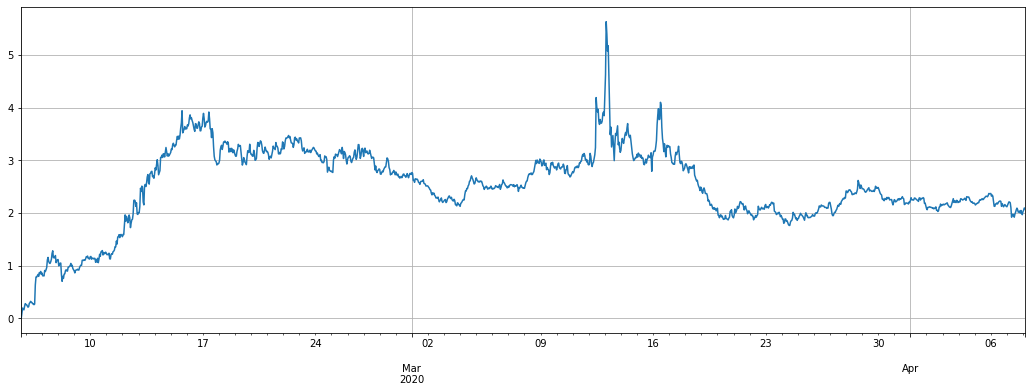
pd.DataFrame(e.account).T.apply(lambda x:round(x,3)) # holding position
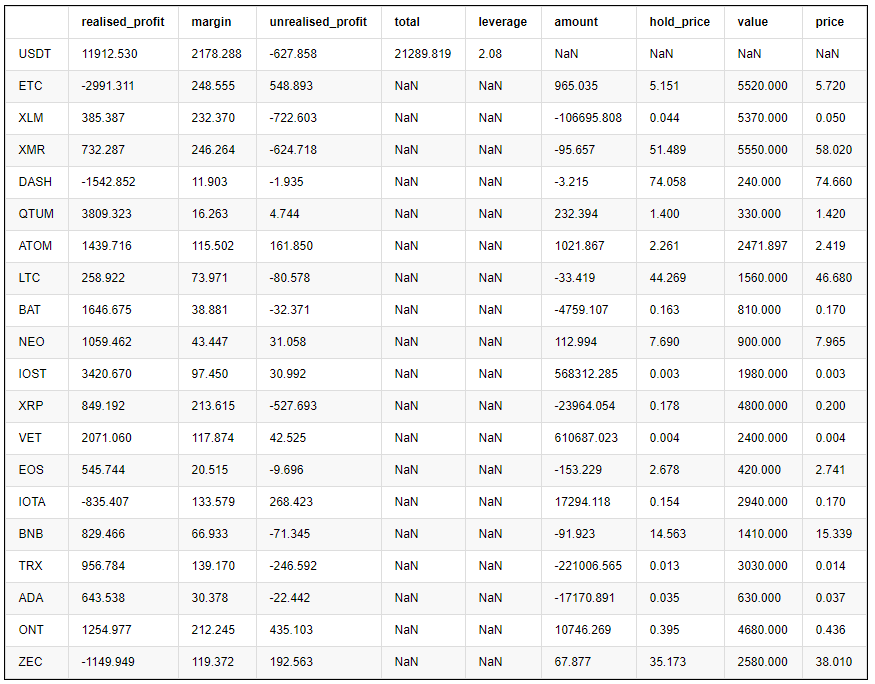
Porquê melhorar
O maior problema original é a comparação entre o preço mais recente e o preço inicial iniciado pela estratégia. À medida que o tempo passa, ele se tornará mais e mais desviado. Vamos acumular muitas posições nessas moedas. O maior problema com a filtragem de moedas é que ainda podemos ter moedas únicas no futuro com base em nossa experiência passada. O seguinte é o desempenho do modo de não filtragem. Na verdade, quando o trade_value = 300, no estágio médio da execução da estratégia, ele já perdeu tudo. Mesmo que não seja, o LINK e o XTZ também mantêm posições acima de 10000USDT, o que é muito grande. Portanto, devemos resolver esse problema no backtest e passar no teste de todas as moedas.
trade_symbols = list(set(symbols)) # Remaining currencies
price_usdt_btc_norm_mean = price_usdt_btc_norm[trade_symbols].mean(axis=1)
e = Exchange(trade_symbols,initial_balance=10000,commission=0.0005,log=False)
trade_value = 300
for row in price_usdt.iloc[:].iterrows():
e.Update(row[0], row[1])
empty_value = 0
for symbol in trade_symbols:
price = row[1][symbol]
if np.isnan(price):
continue
diff = price_usdt_btc_norm.loc[row[0],symbol] - price_usdt_btc_norm_mean[row[0]]
aim_value = -trade_value*round(diff/0.01,1)
now_value = e.account[symbol]['value']*np.sign(e.account[symbol]['amount'])
empty_value += now_value
if aim_value - now_value > 20:
e.Buy(symbol, price, round((aim_value - now_value)/price, 6),round(e.account[symbol]['realised_profit']+e.account[symbol]['unrealised_profit'],2))
if aim_value - now_value < -20:
e.Sell(symbol, price, -round((aim_value - now_value)/price, 6),round(e.account[symbol]['realised_profit']+e.account[symbol]['unrealised_profit'],2))
stragey_2c = e
(stragey_2c.df['total']/stragey_2c.initial_balance).plot(figsize=(17,6),grid = True);
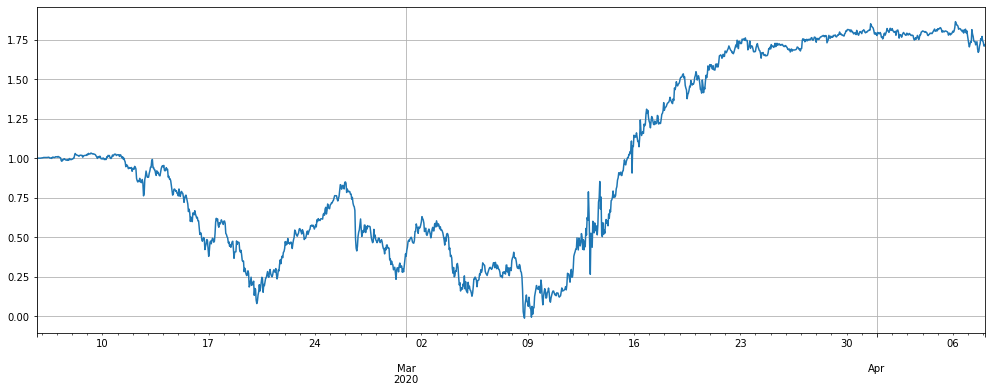
pd.DataFrame(stragey_2c.account).T.apply(lambda x:round(x,3)) # Last holding position

((price_usdt_btc_norm.iloc[-1:] - price_usdt_btc_norm_mean[-1]).T) # Each currency deviates from the initial situation

Uma vez que a causa do problema é comparar com o preço inicial, ele pode ser cada vez mais tendencioso.
Alpha = 0.05
#price_usdt_btc_norm2 = price_usdt_btc/price_usdt_btc.rolling(20).mean() #Ordinary moving average
price_usdt_btc_norm2 = price_usdt_btc/price_usdt_btc.ewm(alpha=Alpha).mean() # Here is consistent with the strategy, using EMA
trade_symbols = list(set(symbols))#All currencies
price_usdt_btc_norm_mean = price_usdt_btc_norm2[trade_symbols].mean(axis=1)
e = Exchange(trade_symbols,initial_balance=10000,commission=0.0005,log=False)
trade_value = 300
for row in price_usdt.iloc[:].iterrows():
e.Update(row[0], row[1])
empty_value = 0
for symbol in trade_symbols:
price = row[1][symbol]
if np.isnan(price):
continue
diff = price_usdt_btc_norm2.loc[row[0],symbol] - price_usdt_btc_norm_mean[row[0]]
aim_value = -trade_value*round(diff/0.01,1)
now_value = e.account[symbol]['value']*np.sign(e.account[symbol]['amount'])
empty_value += now_value
if aim_value - now_value > 20:
e.Buy(symbol, price, round((aim_value - now_value)/price, 6),round(e.account[symbol]['realised_profit']+e.account[symbol]['unrealised_profit'],2))
if aim_value - now_value < -20:
e.Sell(symbol, price, -round((aim_value - now_value)/price, 6),round(e.account[symbol]['realised_profit']+e.account[symbol]['unrealised_profit'],2))
stragey_2d = e
#print(N,stragey_2d.df['total'][-1],pd.DataFrame(stragey_2d.account).T.apply(lambda x:round(x,3))['value'].sum())
O desempenho da estratégia atendeu plenamente às nossas expectativas e os retornos são quase os mesmos. A situação de posições de conta quebradas na moeda original de todas as moedas também passou suavemente, e quase não há retração. O mesmo tamanho da posição de abertura, quase toda a alavancagem está abaixo de 1 vez, em 12 de março de 2020 o preço caiu caso extremo, ainda não excede 4 vezes, o que significa que podemos aumentar o trade_value e, sob a mesma alavancagem, dobrar o lucro. A posição final de detenção é apenas BCH superior a 1000USDT, o que é muito bom.
A estratégia original manterá posições curtas de 300 * 100 = 30000USDT por um longo tempo, e a nova estratégia eventualmente rastreará o preço de referência No último preço, você não manterá nenhuma posição no final.
(stragey_2d.df['total']/stragey_2d.initial_balance).plot(figsize=(17,6),grid = True);
#(stragey_2c.df['total']/stragey_2c.initial_balance).plot(figsize=(17,6),grid = True);
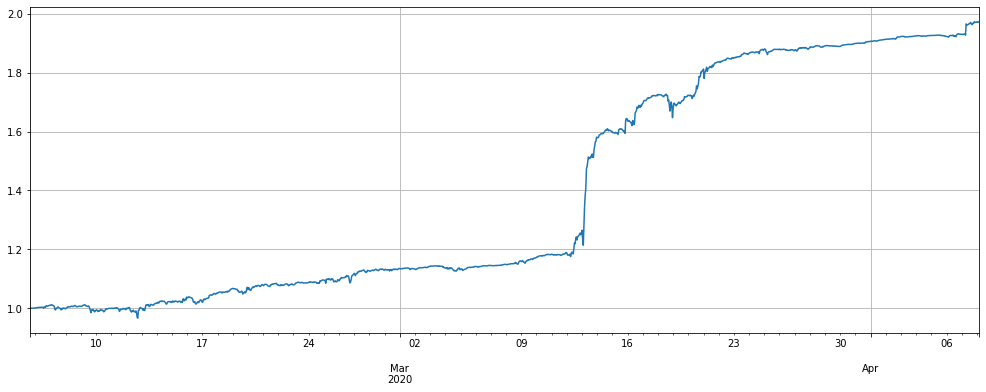
stragey_2d.df['leverage'].plot(figsize=(18,6),grid = True);
stragey_2b.df['leverage'].plot(figsize=(18,6),grid = True); # Screen currency strategy leverage
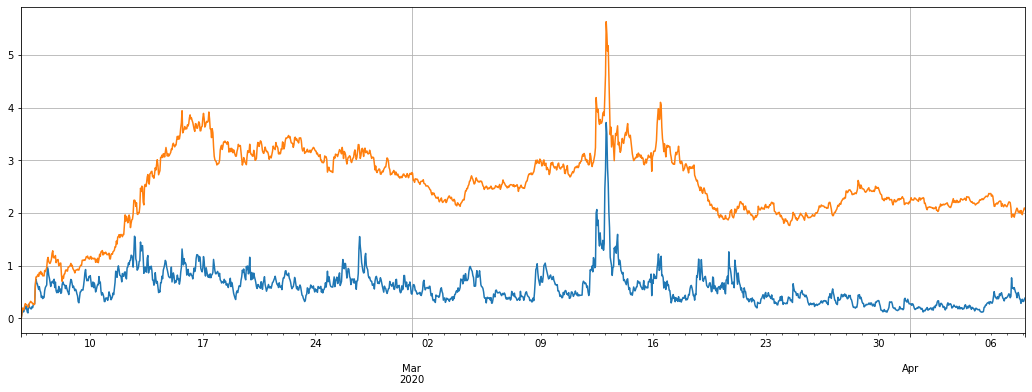
pd.DataFrame(stragey_2d.account).T.apply(lambda x:round(x,3))
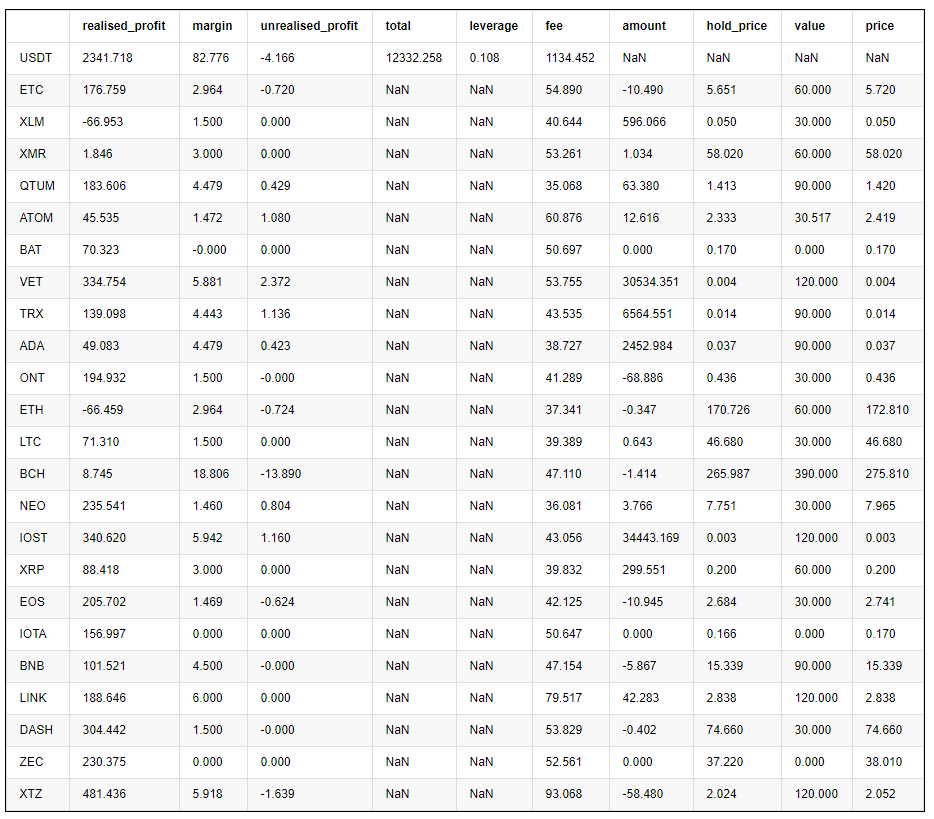
O que acontecerá com a moeda com o mecanismo de triagem, com os mesmos parâmetros, os lucros da fase anterior apresentam melhor desempenho, o retração é menor, mas os retornos globais são ligeiramente menores.
#price_usdt_btc_norm2 = price_usdt_btc/price_usdt_btc.rolling(50).mean()
price_usdt_btc_norm2 = price_usdt_btc/price_usdt_btc.ewm(alpha=0.05).mean()
trade_symbols = list(set(symbols)-set(['LINK','XTZ','BCH', 'ETH'])) # Remaining currencies
price_usdt_btc_norm_mean = price_usdt_btc_norm2[trade_symbols].mean(axis=1)
e = Exchange(trade_symbols,initial_balance=10000,commission=0.0005,log=False)
trade_value = 300
for row in price_usdt.iloc[:].iterrows():
e.Update(row[0], row[1])
empty_value = 0
for symbol in trade_symbols:
price = row[1][symbol]
if np.isnan(price):
continue
diff = price_usdt_btc_norm2.loc[row[0],symbol] - price_usdt_btc_norm_mean[row[0]]
aim_value = -trade_value*round(diff/0.01,1)
now_value = e.account[symbol]['value']*np.sign(e.account[symbol]['amount'])
empty_value += now_value
if aim_value - now_value > 20:
e.Buy(symbol, price, round((aim_value - now_value)/price, 6),round(e.account[symbol]['realised_profit']+e.account[symbol]['unrealised_profit'],2))
if aim_value - now_value < -20:
e.Sell(symbol, price, -round((aim_value - now_value)/price, 6),round(e.account[symbol]['realised_profit']+e.account[symbol]['unrealised_profit'],2))
stragey_2e = e
#(stragey_2d.df['total']/stragey_2d.initial_balance).plot(figsize=(17,6),grid = True);
(stragey_2e.df['total']/stragey_2e.initial_balance).plot(figsize=(17,6),grid = True);
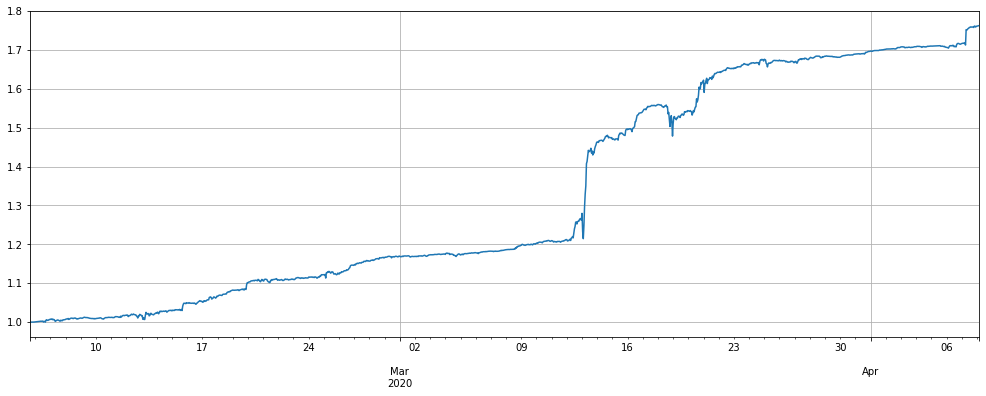
stragey_2e.df['leverage'].plot(figsize=(18,6),grid = True);
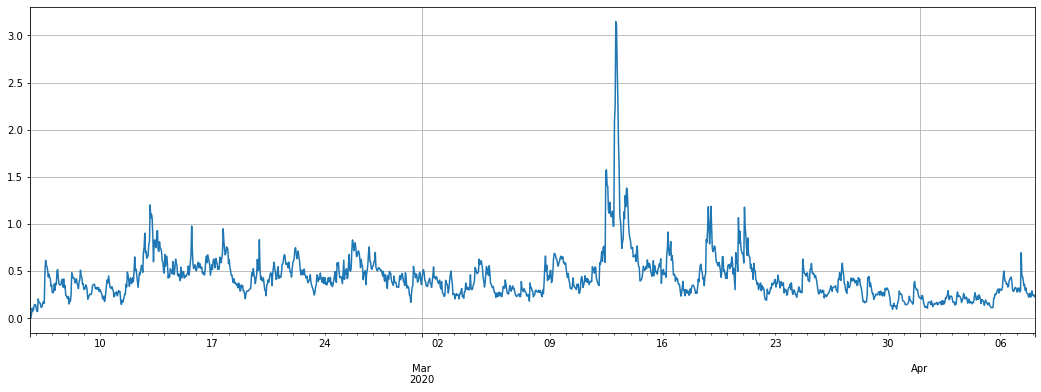
pd.DataFrame(stragey_2e.account).T.apply(lambda x:round(x,3))
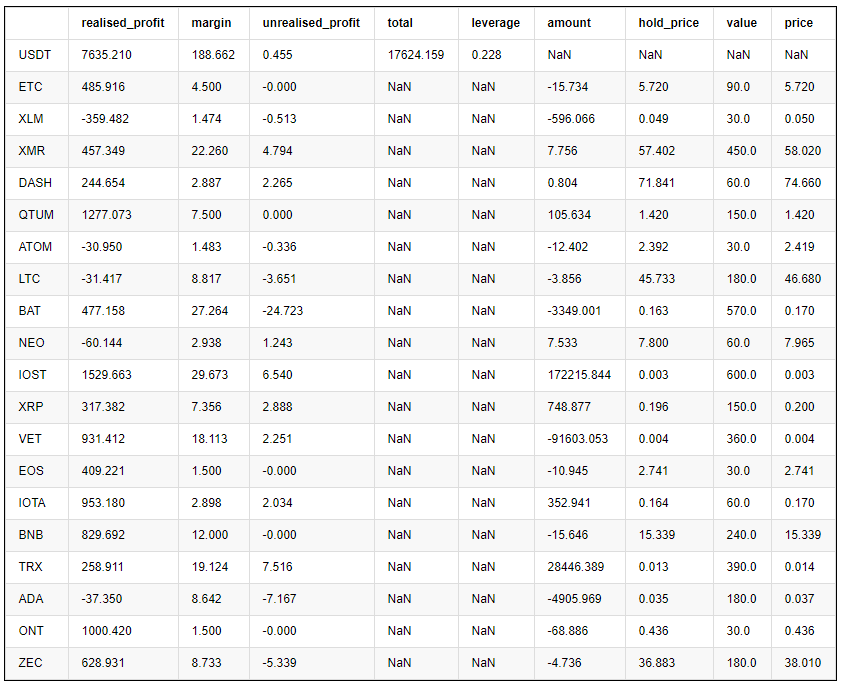
Optimização de parâmetros
Quanto maior a configuração do parâmetro Alpha da média móvel exponencial, mais sensível o rastreamento do preço de referência, menos transações, menor a posição de detenção final. quando a alavancagem é menor, o retorno também é reduzido. Baixar o retracement máximo, pode aumentar o volume de transações. As operações de saldo específicas precisam ser baseadas nos resultados do backtest.
Uma vez que o backtest é uma linha de 1h K, só pode ser actualizado uma vez por hora, o mercado real pode ser actualizado mais rapidamente e é necessário ponderar as configurações específicas de forma abrangente.
Este é o resultado da otimização:
for Alpha in [i/100 for i in range(1,30)]:
#price_usdt_btc_norm2 = price_usdt_btc/price_usdt_btc.rolling(20).mean() # Ordinary moving average
price_usdt_btc_norm2 = price_usdt_btc/price_usdt_btc.ewm(alpha=Alpha).mean() # Here is consistent with the strategy, using EMA
trade_symbols = list(set(symbols))# All currencies
price_usdt_btc_norm_mean = price_usdt_btc_norm2[trade_symbols].mean(axis=1)
e = Exchange(trade_symbols,initial_balance=10000,commission=0.0005,log=False)
trade_value = 300
for row in price_usdt.iloc[:].iterrows():
e.Update(row[0], row[1])
empty_value = 0
for symbol in trade_symbols:
price = row[1][symbol]
if np.isnan(price):
continue
diff = price_usdt_btc_norm2.loc[row[0],symbol] - price_usdt_btc_norm_mean[row[0]]
aim_value = -trade_value*round(diff/0.01,1)
now_value = e.account[symbol]['value']*np.sign(e.account[symbol]['amount'])
empty_value += now_value
if aim_value - now_value > 20:
e.Buy(symbol, price, round((aim_value - now_value)/price, 6),round(e.account[symbol]['realised_profit']+e.account[symbol]['unrealised_profit'],2))
if aim_value - now_value < -20:
e.Sell(symbol, price, -round((aim_value - now_value)/price, 6),round(e.account[symbol]['realised_profit']+e.account[symbol]['unrealised_profit'],2))
stragey_2d = e
# These are the final net value, the initial maximum backtest, the final position size, and the handling fee
print(Alpha, round(stragey_2d.account['USDT']['total'],1), round(1-stragey_2d.df['total'].min()/stragey_2d.initial_balance,2),round(pd.DataFrame(stragey_2d.account).T['value'].sum(),1),round(stragey_2d.account['USDT']['fee']))
0.01 21116.2 0.14 15480.0 2178.0
0.02 20555.6 0.07 12420.0 2184.0
0.03 20279.4 0.06 9990.0 2176.0
0.04 20021.5 0.04 8580.0 2168.0
0.05 19719.1 0.03 7740.0 2157.0
0.06 19616.6 0.03 7050.0 2145.0
0.07 19344.0 0.02 6450.0 2133.0
0.08 19174.0 0.02 6120.0 2117.0
0.09 18988.4 0.01 5670.0 2104.0
0.1 18734.8 0.01 5520.0 2090.0
0.11 18532.7 0.01 5310.0 2078.0
0.12 18354.2 0.01 5130.0 2061.0
0.13 18171.7 0.01 4830.0 2047.0
0.14 17960.4 0.01 4770.0 2032.0
0.15 17779.8 0.01 4531.3 2017.0
0.16 17570.1 0.01 4441.3 2003.0
0.17 17370.2 0.01 4410.0 1985.0
0.18 17203.7 0.0 4320.0 1971.0
0.19 17016.9 0.0 4290.0 1955.0
0.2 16810.6 0.0 4230.6 1937.0
0.21 16664.1 0.0 4051.3 1921.0
0.22 16488.2 0.0 3930.6 1902.0
0.23 16378.9 0.0 3900.6 1887.0
0.24 16190.8 0.0 3840.0 1873.0
0.25 15993.0 0.0 3781.3 1855.0
0.26 15828.5 0.0 3661.3 1835.0
0.27 15673.0 0.0 3571.3 1816.0
0.28 15559.5 0.0 3511.3 1800.0
0.29 15416.4 0.0 3481.3 1780.0
- Prática quantitativa das bolsas DEX (2) -- Guia do utilizador do hiperlíquido
- Práticas de quantificação da DEX Exchange ((2) -- Guia de uso do Hyperliquid
- Prática quantitativa das bolsas DEX (1) -- dYdX v4 Guia do utilizador
- Introdução à arbitragem de lead-lag em criptomoedas (3)
- Práticas de quantificação da DEX exchange ((1) -- dYdX v4 Guia de uso
- Introdução ao conjunto de Lead-Lag na moeda digital (3)
- Introdução à arbitragem de lead-lag em criptomoedas (2)
- Introdução ao suporte de Lead-Lag na moeda digital (2)
- Discussão sobre a recepção de sinais externos da plataforma FMZ: uma solução completa para receber sinais com serviço HTTP em estratégia
- Discussão da recepção de sinais externos da plataforma FMZ: estratégias para o sistema completo de recepção de sinais do serviço HTTP embutido
- Introdução à arbitragem de lead-lag em criptomoedas (1)
- Versão Python Commodity Futures Moving Average Estratégia
- Cotações de mercado coletor atualizar novamente
- Reaproveitamento do coletor de transações - suporte à importação de arquivos no formato CSV para fornecer fontes de dados personalizadas
- Commodity Futures High Frequency Trading Strategy escrito em C++
- Larry Connors RSI2 Estratégia de Reversão Mean
- A mão de Oak ensinou-lhe a usar o JS para pautar a API de extensão FMZ
- Baseado na utilização de um novo índice de força relativa nas estratégias intradiárias
- Pesquisa sobre Binance Futures Multi-currency Hedging Strategy Parte 4
- Larry Connors Larry Connors RSI2 estratégia de retorno da média
- Pesquisa sobre Binance Futures Multi-currency Hedging Strategy Parte 3
- Pesquisa sobre Binance Futures Multi-currency Hedging Strategy Parte 1
- Manual para ensinar você a atualizar o catador de transações para a recuperação de recursos de fontes de dados personalizadas
- Sistema de negociação de linhas de crocodilo versão Python
- A plataforma de negociação quantitativa do inventor é utilizada para realizar o TradingView Alarm Signal Trading (recomendado)
- Versão JavaScript SuperTrend estratégia
- SuperTrend V.1 - Sistema de linha de tendência super
- A estratégia de SuperTrend da versão JavaScript
- [Guerra dos Milênios] Currency Options Multicurrency Hedging Strategy Resultados dos recentes recompostos e retrospectivos da linha K a nível de minutos ((part 4)
- A mão a mão ensina-te a implementar um coletor de transações
- [Guerra dos Milênios] Forex Forex Forex Forex Forex Forex Forex Forex Forex Forex Forex Forex Forex Forex Forex Forex Forex Forex Forex Forex Forex Forex Forex Forex Forex Forex Forex Forex Forex Forex Forex Forex Forex Forex Forex Forex Forex Forex Forex Forex Forex Forex Forex Forex Forex Forex Forex Forex Forex Forex Forex Forex Forex Forex Forex Forex Forex Forex Forex Forex Forex Forex Forex Forex Forex Forex Forex Forex Forex Forex Forex Forex Forex Forex Forex Forex Forex Forex Forex Forex Forex Forex Forex Forex Forex Forex Forex Forex Forex Forex Forex Forex Forex Forex Trading Forex Forex Forex Forex Forex Forex Forex Forex Forex Forex Forex Forex Forex 3rd edition)